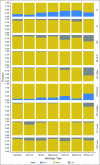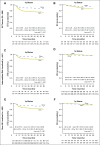Gain of 1q As a Prognostic Biomarker in Wilms Tumors (WTs) Treated With Preoperative Chemotherapy in the International Society of Paediatric Oncology (SIOP) WT 2001 Trial: A SIOP Renal Tumours Biology Consortium Study
- PMID: 27432915
- PMCID: PMC5505170
- DOI: 10.1200/JCO.2015.66.0001
Gain of 1q As a Prognostic Biomarker in Wilms Tumors (WTs) Treated With Preoperative Chemotherapy in the International Society of Paediatric Oncology (SIOP) WT 2001 Trial: A SIOP Renal Tumours Biology Consortium Study
Erratum in
-
Errata.J Clin Oncol. 2017 Jun 20;35(18):2100. doi: 10.1200/JCO.2017.74.0787. J Clin Oncol. 2017. PMID: 28618242 Free PMC article. No abstract available.
Abstract
Purpose: Wilms tumor (WT) is the most common pediatric renal tumor. Treatment planning under International Society of Paediatric Oncology (SIOP) protocols is based on staging and histologic assessment of response to preoperative chemotherapy. Despite high overall survival (OS), many relapses occur in patients without specific risk factors, and many successfully treated patients are exposed to treatments with significant risks of late effects. To investigate whether molecular biomarkers could improve risk stratification, we assessed 1q status and other potential copy number biomarkers in a large WT series.
Materials and methods: WT nephrectomy samples from 586 SIOP WT 2001 patients were analyzed using a multiplex ligation-dependent probe amplification (MLPA) assay that measured the copy number of 1q and other regions of interest.
Results: One hundred sixty-seven (28%) of 586 WTs had 1q gain. Five-year event-free survival (EFS) was 75.0% in patients with 1q gain (95% CI, 68.5% to 82.0%) and 88.2% in patients without gain (95% CI, 85.0% to 91.4%). OS was 88.4% with gain (95% CI, 83.5% to 93.6%) and 94.4% without gain (95% CI, 92.1% to 96.7%). In univariable analysis, 1q gain was associated with poorer EFS (P < .001; hazard ratio, 2.33) and OS (P = .01; hazard ratio, 2.16). The association of 1q gain with poorer EFS retained significance in multivariable analysis adjusted for 1p and 16q loss, sex, stage, age, and histologic risk group. Gain of 1q remained associated with poorer EFS in tumor subsets limited to either intermediate-risk localized disease or nonanaplastic localized disease. Other notable aberrations associated with poorer EFS included MYCN gain and TP53 loss.
Conclusion: Gain of 1q is a potentially valuable prognostic biomarker in WT, in addition to histologic response to preoperative chemotherapy and tumor stage.
© 2016 by American Society of Clinical Oncology.
Conflict of interest statement
Authors’ disclosures of potential conflicts of interest are found in the article online at
Figures


Similar articles
-
Association of Chromosome 1q Gain With Inferior Survival in Favorable-Histology Wilms Tumor: A Report From the Children's Oncology Group.J Clin Oncol. 2016 Sep 10;34(26):3189-94. doi: 10.1200/JCO.2015.66.1140. Epub 2016 Jul 11. J Clin Oncol. 2016. PMID: 27400937 Free PMC article.
-
The Clinical Impact of Somatic Copy Number Variations in Patients With Stage IV Wilms Tumor Enrolled in the SIOP 2001 Trial and Study.Pediatr Blood Cancer. 2025 Apr;72(4):e31580. doi: 10.1002/pbc.31580. Epub 2025 Feb 3. Pediatr Blood Cancer. 2025. PMID: 39895484
-
Gain of 1q is associated with inferior event-free and overall survival in patients with favorable histology Wilms tumor: a report from the Children's Oncology Group.Cancer. 2013 Nov 1;119(21):3887-94. doi: 10.1002/cncr.28239. Epub 2013 Aug 26. Cancer. 2013. PMID: 23983061 Free PMC article.
-
Risk stratification for wilms tumor: current approach and future directions.Am Soc Clin Oncol Educ Book. 2014:215-23. doi: 10.14694/EdBook_AM.2014.34.215. Am Soc Clin Oncol Educ Book. 2014. PMID: 24857079 Review.
-
Optimal neoadjuvant chemotherapy duration in Wilms tumour with intravascular thrombus: A literature review and evidence from SIOP WT 2001 trial.Pediatr Blood Cancer. 2019 Nov;66(11):e27930. doi: 10.1002/pbc.27930. Epub 2019 Jul 24. Pediatr Blood Cancer. 2019. PMID: 31339231
Cited by
-
Validation of a non-oncogene encoded vulnerability to exportin 1 inhibition in pediatric renal tumors.Med. 2022 Nov 11;3(11):774-791.e7. doi: 10.1016/j.medj.2022.09.002. Epub 2022 Oct 3. Med. 2022. PMID: 36195086 Free PMC article.
-
Prediction of outcome in newly diagnosed myeloma: a meta-analysis of the molecular profiles of 1905 trial patients.Leukemia. 2018 Jan;32(1):102-110. doi: 10.1038/leu.2017.179. Epub 2017 Jun 6. Leukemia. 2018. PMID: 28584253 Free PMC article.
-
Prognostic significance of age in 5631 patients with Wilms tumour prospectively registered in International Society of Paediatric Oncology (SIOP) 93-01 and 2001.PLoS One. 2019 Aug 19;14(8):e0221373. doi: 10.1371/journal.pone.0221373. eCollection 2019. PLoS One. 2019. PMID: 31425556 Free PMC article.
-
Differential expression profiling of onco and tumor-suppressor genes from major-signaling pathways in Wilms' tumor.Pediatr Surg Int. 2022 Nov;38(11):1601-1617. doi: 10.1007/s00383-022-05202-2. Epub 2022 Sep 15. Pediatr Surg Int. 2022. PMID: 36107237
-
Molecular Characterization Reveals Subclasses of 1q Gain in Intermediate Risk Wilms Tumors.Cancers (Basel). 2022 Oct 5;14(19):4872. doi: 10.3390/cancers14194872. Cancers (Basel). 2022. PMID: 36230794 Free PMC article.
References
-
- Breslow N Olshan A Beckwith JB, etal: Epidemiology of Wilms tumor Med Pediatr Oncol 21:172–181,1993 - PubMed
-
- Pritchard-Jones K Moroz V Vujanic G, etal: Treatment and outcome of Wilms’ tumour patients: An analysis of all cases registered in the UKW3 trial Ann Oncol 23:2457–2463,2012 - PubMed
-
- Kalapurakal JA Dome JS Perlman EJ, etal: Management of Wilms’ tumour: Current practice and future goals Lancet Oncol 5:37–46,2004 - PubMed
-
- Vujanić GM Sandstedt B Harms D, etal: Revised International Society of Paediatric Oncology (SIOP) working classification of renal tumors of childhood Med Pediatr Oncol 38:79–82,2002 - PubMed
-
- Pritchard-Jones K Bergeron C de Camargo B, etal: Omission of doxorubicin from the treatment of stage II-III, intermediate-risk Wilms’ tumour (SIOP WT 2001): An open-label, non-inferiority, randomised controlled trial Lancet 386:1156–1164,2015 - PubMed
Publication types
MeSH terms
Substances
Associated data
Grants and funding
LinkOut - more resources
Full Text Sources
Other Literature Sources
Medical
Research Materials
Miscellaneous

